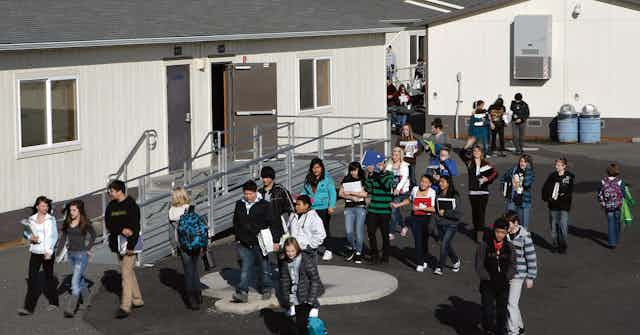Portable classrooms, also known as mobile classrooms, are stand-alone modular structures used when schools cannot accommodate growing student populations. They can provide relief in overcrowded schools while permanent accommodations are built, but there are concerns about their use.
Parents in Moncton, N.B., recently signed an open letter about how long an overcrowded school is expected to make due with apparently temporary portables, citing cold temperatures and students needing to change buildings to use the washroom. In B.C., The Surrey Teachers Association has complained about portables lacking heating.
My research has investigated how long schools in the largest school boards in Ontario keep portables on site, as well as the average number of portables per school. My findings indicate that in many cases, portable classrooms are far from being temporary accommodations, and instead, are used as permanent instructional structures.
Low cost
Many school districts in Canada and the United States rely on portables as prefabricated facilities when the need for classroom space increases and the budget for school construction is limited.
Portables are preferred for their fast deployment and low upfront cost.
But studies on environmental conditions of portable classrooms have reported concerns with indoor air quality, temperature control, noise levels, water leaks and mould.
Having high numbers of portables at a school has also been associated with congestion in common learning spaces, declines in academic achievement, and absenteeism.
Portables are not new and have been part of kindergarten to Grade 12 education since the mid-20th century.

Examining 10 years of portables
I collected 10 years of portable use records (2010-2020) from approximately 2,700 schools in the 27 largest school boards in Ontario. This sample represents about 55 per cent of the schools in the province, serving nearly 63 per cent of the student population.
On average, school boards in the sample used nearly 5,300 portables per year between 2010 and 2020. Two-thirds of the schools in the sample had at least one portable classroom during the 10-year period, with an average of three portables per school. Half of the schools had between one and four portables. In contrast, 35 per cent did not use portables in this period.
While there are no specific criteria to determine what “temporary” means in relation to portable classroom use, it can be argued that portables are needed until a permanent facility is built, or until overcrowding is resolved.
In Ontario, it typically takes between two and four years to build a new school. Therefore, using a portable classroom for more than four years surpasses the expected time frame for temporary accommodation.
Lack of planning for student growth
My analysis revealed that 20 per cent of the sampled schools used portables for one to four years and 45 per cent had portables for five to 10 years.
In addition to revealing that portables tend to become permanent, the study showed the average number of portables remained stable over the 10-year period. This suggests school boards in Ontario, and likely in other provinces, have become dependent on temporary facilities to address overcrowding.
Several interrelated factors could help explain this situation. First, there is the issue of lack of planning. In 2009, a working group with the Ministry of Education projected that school boards in the Greater Toronto Area (GTA) would see enrolment growth. This study confirmed that urban areas in Ontario, including the GTA, experienced a 10 per cent average enrolment increase, yet despite the rise in enrolment, the average number of portables remained stable.
Tensions with urban planning
Second, there is the effect of urban sprawl on school planning. As more families move to suburban neighbourhoods, local schools need to rely on portables to alleviate overcrowding.
Inner-city schools, which often serve minoritized students, experience enrolment decline, which puts them at risk of closure.
Third, there is a tension between urban planning and school planning. Undergoing processes of urban change, like urban sprawl and gentrification, forces school boards to stretch out resources that otherwise could be concentrated in fewer areas.

School boards are forced to play catch up to city development, making planning a more difficult and less predictable task. The absence of formal mechanisms for school boards to have a say on urban growth makes school planning an afterthought to municipal planning.
Finally, there is the issue of funding. Funding cuts and austerity in Ontario public education are not new. For instance, in 2019, the province reported a $16.3 billion backlog in school repairs.
More proactive approach needed
Since only the most urgent cases of overcrowding are selected for funding, school boards can wait for several years until requests for new schools are approved.
The process to fund new schools is so slow and reactive, that it is common for new schools to receive portables shortly after opening.
Normalizing temporary structures as permanent educational facilities undermines the goal of providing quality public education to all children.
Portables are not a solution, but a symptom of overcrowding. A more proactive approach to school planning is required.

